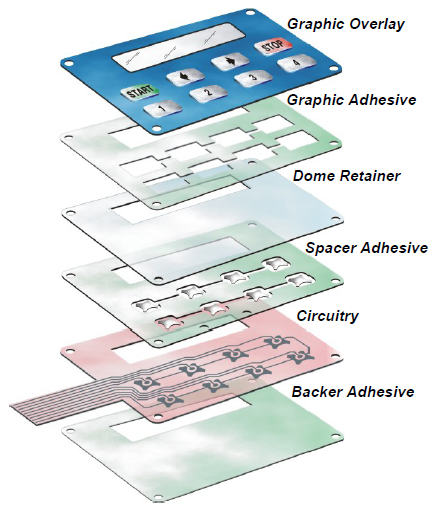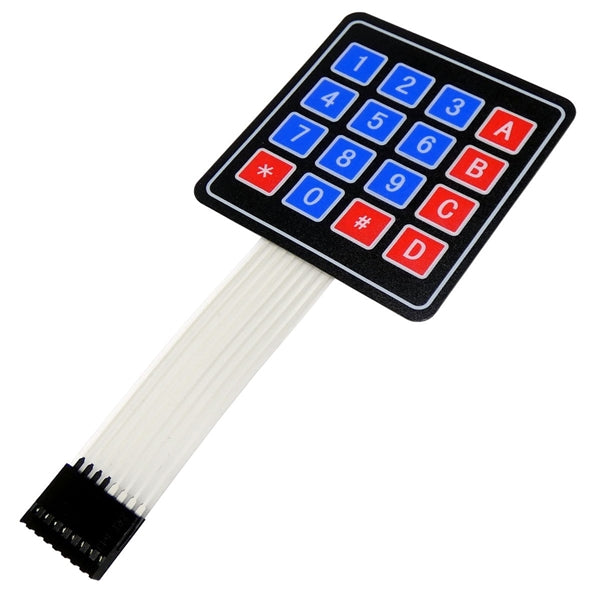Exploring the Manufacturing Process of Custom Membrane Switches
Membrane Layer Switch Over Modern Technology: The Key to Dependable and Economical User Interfaces
Membrane layer button technology has arised as an essential part in the layout of user interfaces, providing both dependability and cost-effectiveness across a varied variety of applications. As we check out the complex advantages of membrane layer switches, their potential for technology elevates questions about future applications and developing patterns.
Understanding Membrane Layer Switch Over Modern Technology
Membrane layer button modern technology is a commonly used interface solution in different digital tools, using a seamless blend of functionality and style. This modern technology includes multiple layers of materials, usually including a graphic overlay, spacer layer, and a circuit layer. The visuals overlay shows the interface aspects, while the spacer layer divides the circuit layer from the overlay till an individual triggers a switch.
When stress is related to the overlay, the circuit layer completes the electric circuit, sending out a signal to the device. This mechanism enables different arrangements, consisting of responsive responses and backlighting choices, improving customer communication. Membrane switches are commonly produced using durable products such as polyester or polycarbonate, making sure durability and resistance to ecological aspects like moisture and dirt.
The adaptability of membrane switches over enables their application in varied industries, consisting of medical tools, consumer electronic devices, and commercial controls. Their portable design permits combination into space-constrained settings, offering an effective user interface without jeopardizing aesthetic allure. Understanding the details of membrane button innovation is essential for suppliers and designers looking for to create trusted and reliable human-machine user interfaces.
Secret Advantages of Membrane Layer Switches
While different user interface services exist, membrane switches over deal unique benefits that make them a preferred option in countless applications. One of the primary benefits is their sturdiness; membrane layer buttons are designed to withstand harsh ecological problems, including wetness, dust, and temperature level fluctuations, making certain resilient performance. This strength substantially lowers the demand for constant substitutes, thereby lowering overall upkeep prices.

In addition, membrane switches are lightweight and portable, making them ideal for applications where area is restricted. Their inconspicuous design adds to a streamlined appearance without compromising capability.
Cost-effectiveness is additionally a remarkable benefit, as the production procedure for membrane changes has a tendency to be more economical contrasted to conventional mechanical switches. This price, integrated with their dependability and ease of setup, positions membrane switches as a practical option for a large range of sectors seeking reliable and reliable interface.
Applications Throughout Different Industries
Just how do membrane layer switches adapt to the varied requirements of various industries? Membrane layer switch innovation is increasingly recognized for its convenience, making it appropriate for a variety of applications throughout numerous industries. In the clinical field, membrane layer buttons are utilized in analysis equipment and individual monitoring devices, where their toughness and simplicity of cleaning are vital for maintaining hygiene requirements. The auto industry utilizes these buttons in dashboards and control panels, using a streamlined visual while guaranteeing straightforward procedure.
In customer electronics, membrane buttons provide a small option for remote controls and home appliances, boosting user experience via user-friendly design. Furthermore, the industrial sector leverages membrane switches for equipment control panels, taking advantage of their resistance to extreme settings, such as dampness and dirt.
Military and aerospace applications likewise utilize membrane layer buttons for their dependability and capability to hold up against extreme conditions, ensuring functional performance in essential scenarios. Furthermore, the food and beverage market takes on these switches for automated systems, where cleanliness and simplicity of procedure are vital. Ultimately, membrane switches are tailored to satisfy the unique demands of each market, verifying their vital function in modern innovation user interfaces
Style and Modification Choices

In the world of membrane layer button modern technology, layout and customization alternatives play an essential function in enhancing performance and individual interaction. These buttons can be tailored to meet details functional demands and aesthetic preferences, making them versatile parts in different applications.
One of the primary modification options is the format of the switch itself, which can be made to fit special interface and ergonomic factors to consider. By changing the form, size, and setup of switches, manufacturers can produce instinctive designs that facilitate simplicity of use. Furthermore, the incorporation of various colors and visuals overlays permits branding and boosted exposure, making certain that individuals can promptly identify features.
Moreover, membrane layer switches can find out here now be crafted with various responsive responses systems, such as elevated switches or distinct clicks, to boost the individual experience. Various materials can likewise be selected for toughness and ecological resistance, attending to factors such as wetness, temperature level fluctuations, and chemical exposure.
Inevitably, the comprehensive layout and personalization options readily available in membrane switch modern technology empower services to create tailored remedies that not just fulfill functional requirements however likewise straighten with their branding and operational requirements.

Future Trends in Membrane Buttons
As membrane switch technology remains to progress, future fads are increasingly focused on improving customer experience and incorporating advanced functionalities. One significant trend is the combination more tips here of touch-sensitive and capacitive innovations right into standard membrane layer buttons. This development permits for even more intuitive individual interfaces, giving responsive comments while keeping a smooth style.
One more emerging pattern is the use of eco-friendly products, driven by the expanding demand for lasting manufacturing methods. Producers are looking for to reduce their carbon impact by making use of recyclable substratums and low-impact inks, aligning with global sustainability objectives.
In addition, the surge of the Internet of Points (IoT) is motivating the incorporation of wise features right into membrane layer buttons. Boosted connection alternatives will certainly enable gadgets to interact with each other, permitting seamless assimilation right into broader systems.
In addition, advancements in printing technologies, such as electronic printing, are enabling for greater layout versatility and customization. This makes it possible for producers to create complex layouts and vivid shades cost-effectively.

Verdict
In final thought, membrane button innovation stands for an important innovation in user interface design, supplying considerable benefits in toughness, customization, and cost-effectiveness. Its prevalent applicability across varied sectors highlights its importance in modern-day technology. As improvements continue to arise, particularly in touch-sensitive user interfaces and sustainable materials, the potential for membrane layer switches over to enhance individual experience check it out and functionality continues to be appealing. Proceeded exploration of this innovation will likely produce better improvements and widen its extent in future applications.